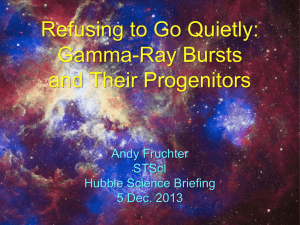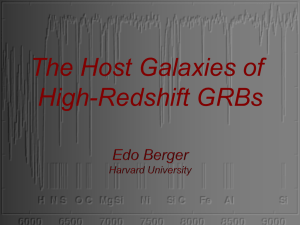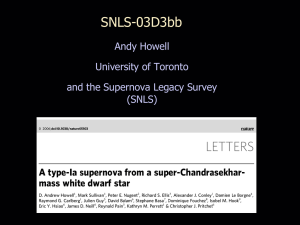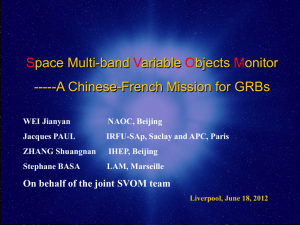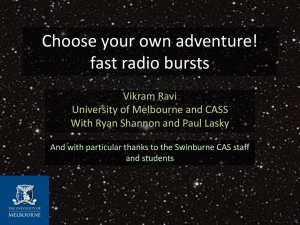Low luminosity GRBs as a different class and shock breakout events
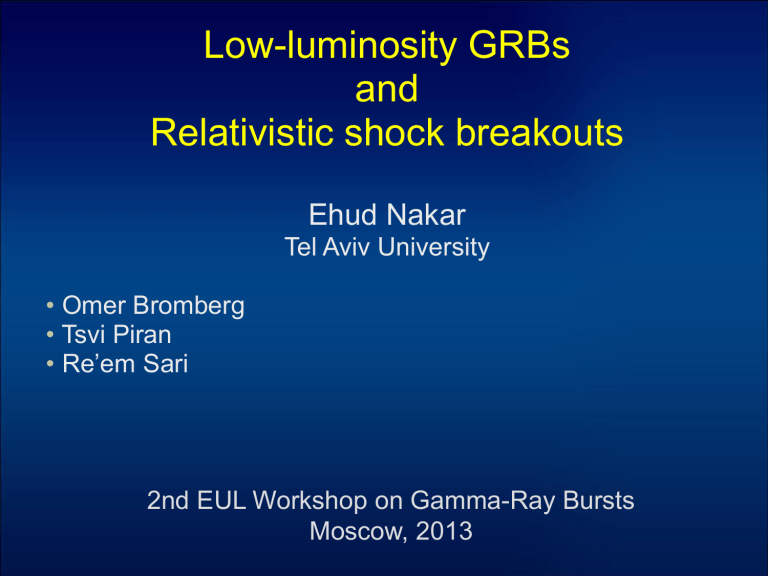
Low-luminosity GRBs and
Relativistic shock breakouts
Ehud Nakar
Tel Aviv University
• Omer Bromberg
• Tsvi Piran
• Re’em Sari
2nd EUL Workshop on Gamma-Ray Bursts
Moscow, 2013
Outline
• Observational properties of Low-luminosity GRBs
• Why low-luminosity GRBs are unlikely to be generated by “successful” jets (as long GRBs)
• Theory of relativistic shock breakout ( gb
>0.5)
• Comparison of relativistic shock breakout predictions to low-luminosity GRB observations
• Shock breakout in regular long GRBs
Low-luminosity GRBs
There are 4 low-luminosity GRBs observed to date with a confirmed associated SNe and known redshifts.
• Two with regular duration (~20 s) and two are very long
(~2000 s)
• All are nearby, ~40-400 Mpc.
• All are associated with a very rare supernova type: Broadline Ic SNe
• Nearby long GRBs are also associated with similar unique type of SNe
Low-luminosity GRB high energy emission is very different than that of long GRBs
The strong connection between the two types is based on the mutual association with Broad-line Ic SNe
Properties of low-luminosity GRBs
• Low luminosity 10 46 -10 48 erg/s (~10 -4 than long GRBs) and low energy 10 48 - 10 50 erg
Swift GRBs
Properties of low-luminosity GRBs
• Low luminosity 10 46 -10 48 erg/s (~10 -4 than long GRBs) and low energy 10 48 - 10 50 erg
• High volumetric rate (x1000 that of long GRBs).
Not an extrapolation of long GRB rate to low luminosities
Low luminosity
Short
Long
Wanderman & Piran 2011
Properties of low-luminosity GRBs
• Low luminosity 10 46 -10 48 erg/s (~10 -4 than long GRBs) and low energy 10 48 - 10 50 erg
• High volumetric rate (x100 that of long GRBs).
Not an extrapolation of long GRB rate to low luminosities
• Smooth light curves (very rare among long GRBs)
Properties of low-luminosity GRBs
• Low luminosity 10 46 -10 48 erg/s (~10 -4 than long GRBs) and low energy 10 48 - 10 50 erg
• High volumetric rate (x100 that of long GRBs).
Not an extrapolation of long GRB rate to low luminosities
• Smooth light curves (very rare among long GRBs)
• E g << total kinetic energy in the explosion (~10 52
• The gamma-rays are not highly collimated erg)
• Mildly relativistic ejecta with energy ~ E g
• Delayed X-ray emission, with energy ~ E g
Low-Luminosity GRBs are very different than long GRBs.
But, can they be produced in the same way?
Long GRBs are generated by relativistic jets that successfully
“punch” through their progenitor envelopes
Zhang et al., 04
Can lowluminosity GRBs be produced by “successful” jets?
Before the jet punches through the star its energy is dissipated into its envelope
After the jet breaks out energy flows (relatively) freely to large distances where the prompt GRB emission is emitted.
GRB duration
Engine
Work time t
γ
= t e
- t b
Time for jet to break out t b t
γ
t e
The engine is unaware that the jet breaks out
t b t e t g
Long GRBs
Low-luminosity
0.01
0.1
T
90
/t b
1 10
Bromberg, EN & Piran 2011
Low-luminosity GRBs are most likely (2 s
) not produced by jets that successfully punches through their progenitor envelope
If not a successful jet then what is the g
-ray source of low-luminosity GRBs?
Even “failed” jets drive shocks that breakout of the stellar surface!
“failed” jets are m uch more frequent than successful ones (Bromberg et al
12)
What are the observed signatures of the resulting shock breakouts?
Relativistic shock breakout
(EN & Sari 2012)
radiation-dominated shock
Energy release
Shock accelerates in steep density gradient
Shock breakout
“first light”
Continuous diffusion
Shock breakout
A self-similar radiation dominated shock is accelerating through the envelope, gr
-0.23
(Johnson & Mckee 1971, Tan et al 2001,
Pan & Sari 2006) log r log r
Shock breakout
A self-similar radiation dominated shock is accelerating through the envelope, gr
-0.23
(Johnson & Mckee 1971, Tan et al 2001,
Pan & Sari 2006)
Shock width = distance to edge log r
Three hydrodynamic stages
Shock breakout
Shock width = distance to edge
Planar expansion
Before breakout layer doubles its radius
Spherical expansion
After Breakout layer doubles its radius
Colgate (1968):
SNe shocks before breakout:
1. very high Lorentz factor
2. radiation dominated at thermal equilibrium
Burst of g
-rays (in some SNe and other explosions)
The temperature behind the shock
Constant (independent of g sh temperature ~100-200 keV
) post shock rest frame
10
2 Katz et. al., 10
Budnik et. al., 10
10
1
10
0
10
-1
10
-2
10
4
V (km/s) pairs
10
5
T
BB
The Observed temperature
• Following breakout the expanding gas accelerates up to g final
g
1
3 initial
(for g final
30 )
• The gas is loaded with pairs, trapping the radiation
• The trapped radiation can be released only when pairs annihilate at T`≈50 keV
T bo
50 g bo keV
Observed energy
The breakout energy is released from a region with Thomson optical depth ~ 1 (without pairs) m bo
2
10
10
R bo
R sun
2
M sun
E bo
m bo c
2 g
1
3 /
bo
2
4
10
44 g
1
3 /
bo
2
R bo
R sun
2 erg
Observed duration
Light travel time dominates the breakout duration t bo
2
R bo g
2 bo
R sun s
The Observed signature of a relativistic breakout
E bo
10
44 g
1
3 /
bo
2
R bo
R sun
2 erg
T bo
50 g bo keV t bo
2
R bo g
2 bo
R sun s
Three observables depend on two physical parameters t bo
20 s
E bo
10 46 erg
1 / 2
T bo
50 keV
2 .
7
Relativistic breakout relation
Emission following the shock breakout g
-rays
X-rays
EN & Sari 12
E p shifts from g
-rays to X-rays (E x
> E g
)
Which explosions are expected to have relativistic breakouts?
EN & Sari 11 g bo
14
E exp losion
10
53 erg
1 .
7
M ejecta
5 M sun
1 .
2
R
*
5 R sun
0 .
95
Other Predictions of relativistic shock breakouts:
• Smooth light curve
•
E g << total energy
• Relativistic ejecta with energy ~ E g
• Delayed X-ray emission, with energy ~ E g
• If the breakout is due to failed jets than rate >> than long
GRBs
Relativistic breakout relation
?
t bo
20 s
E bo
10
46 erg
1 / 2
T bo
50 keV
2 .
7
Low luminosity GRBs
GRB E bo
(erg)
T bo
(keV) t bo
(s)
980425 10 48 150 30
031203 5
10 49 >200 30
060218 5
10 49 40 2100
100316D 5
10 49 40 1300
Relation t bo
(s)
10
<35
1500
1500
6
R bo
(cm)
10 12 gb
3 bo
2
10 13 >4
5
10 13
5
10 13
1
1 t bo
20 s
E bo
10
46 erg
1 / 2
T bo
50 keV
2 .
7
Relativistic breakout relation
A Wolf-Rayet with a radius of a red supergiant?
• Only a mass of 10 -4 M ʘ is needed at this radius to produce the observed shock breakout
• Recent early time SNe light curves indicates on a compact massive mantle and a low mass extended envelope
Shock breakout from long GRBs
A short, hard and faint pulse at the beginning of the burst
E bo
~ 10
48
R bo
5 R sun
2 erg
T bo
MeV t bo
~ m s
Summary
• Low-luminosity GRBs are fundamentally different than long GRBs
•
Relativistic breakouts produce g
-ray flares with characteristic properties:
•
E bo
– T
• smooth bo
– t bo relation (if quasi-spherical without a wind)
• a small fraction of total explosion energy
• g to X-ray evolution
• generate a relativistic outflow with E~E bo
•
Low-luminosity GRBs show all these characteristics
• Failed jets is the most natural mechanism (explains also the high low luminosity GRB rate)
Thanks
g
-ray flares from relativistic shock breakouts are expected in a range of other explosions. For example,
White dwarf explosions (Type Ia and .Ia SNe and AIC):
E bo
~ 10
40
10
42 erg
T bo t bo
~ MeV
~ 1
30 ms
Extremely energetic and compact supernovae (e.g., SN 2002ap):
E bo
~ 10
44
10
46 erg
T bo
~ 100 keV t bo
~ 3
30 s
